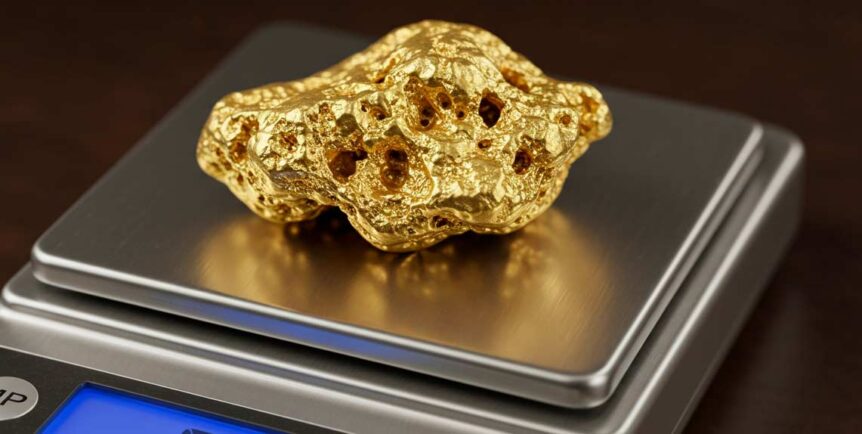Gold isn’t just admired for its gleam; it’s also known for being surprisingly heavy. As one of the densest precious metals, gold holds a special place in industries like jewelry, electronics, and investment. Its density gives it a sense of permanence and value, traits that have made it a symbol of wealth for centuries. Whether you’re holding a small gold coin or a heavy gold bar, the weight you feel is thanks to gold’s compact and dense atomic structure.
Why is density so important? It’s simple: the denser a material, the heavier it is for its size. This means that even small amounts of gold pack significant weight. Understanding gold’s density is essential when thinking about its various forms, from pure gold (24-carat) to gold alloys used in jewelry. This knowledge helps us appreciate why gold has been treasured for so long—both for its beauty and its physical properties.
| Key Takeaways |
|---|
| Gold is one of the densest precious metals, with a density of 19.32 g/cm³, making it much heavier than most other materials. |
| Gold’s weight plays a key role in determining its value, especially in items like gold coins and gold jewelry. |
| When alloyed with other metals like copper or silver, gold’s density decreases slightly, impacting both its weight and durability. |
| Gold’s high density helps miners separate it from lighter materials during gold mining. |
| Measuring gold’s density is a useful way to check its purity and distinguish real gold from imitations. |
| The density of gold has practical implications in pricing and investment, influencing how gold is traded and valued across markets. |

Start buying precious metals at cost.
Understanding the Density of Gold
So, what exactly is density? In simple terms, it’s how much something weighs in relation to its size. For gold, its density is 19.32 g/cm³, or 19,320 kilograms per cubic meter (kg/m³), which is remarkably high compared to many other metals. To put that in perspective, this means gold is much heavier than most materials of the same volume. If you compare a gold ring to a ring made from silver or copper, the gold ring will always feel significantly heavier.
This density results from the tightly packed arrangement of gold atoms. Each atom in gold’s structure sits close to the others, creating a compact, solid material. In practical terms, this density is what gives gold its “heft,” making even a small piece of gold feel weighty in your hand. It’s why gold played an essential part in early coinage systems, where heavier items were often equated with higher value and one reason why gold is often associated with luxury and high value—there’s something satisfying about its solid, weighty feel.
Density of Pure Gold vs Other Precious Metals
| Metal / Alloy | Density (g/cm³) |
| Gold (24-carat) | 19.32 |
| Platinum | 21.45 |
| Palladium | 12.02 |
| Silver | 10.49 |
| Copper | 8.96 |
| White Gold* | ~14.0 – 19.3 *Alloys will vary |
| Rose Gold* | ~15.0 – 17.8 *Alloys will vary |
Gold’s density of 19.32 g/cm³ sets it apart from metals like silver and platinum. Silver, at 10.49 g/cm³, is much lighter, while platinum, denser at 21.45 g/cm³, is mostly used in industrial applications. Gold, by contrast, is prized in jewelry, currency, and electronics.
When comparing gold to lighter metals like copper, the difference is even more striking. Copper has a density of only 8.96 g/cm³, meaning gold is more than twice as heavy for the same volume. This weight difference impacts how items like gold coins or jewelry feel and how much metal is needed for a specific design.
Impact of Gold Purity on Density
The density of pure gold (24-carat) is always the same: 19.32 g/cm³. But, as shown in the table above, when gold is mixed with other metals to create alloys like 18-carat gold, the overall density decreases slightly. This happens because metals like copper and silver, often used to strengthen gold, are less dense. The result is a lighter, more durable metal that’s better suited for everyday jewelry.
For example, rose gold gets its lovely pinkish hue from the addition of copper, which also makes it a bit lighter than pure gold. Similarly, white gold contains metals like palladium or nickel, giving it a silvery-white appearance while slightly reducing its density. These alloys are popular in jewelry because they combine the beauty of gold with increased strength, all while maintaining a significant portion of gold’s weight.
When you hold a piece of 24-carat gold jewelry, it feels denser and softer than a piece of 18-carat jewelry. This balance between density and durability is what makes alloyed gold practical for many uses, especially in gold coins, rings, and other items meant to withstand daily wear.
Practical Implications of Gold’s Density
Gold’s density isn’t just a cool fact—it plays a key role in many practical applications, especially in gold mining. Because gold is much heavier than the other sediments it’s typically found with, miners can separate gold from lighter materials using techniques like panning. In this process, gold flakes sink to the bottom, while lighter materials float to the top, allowing miners to collect the denser gold.
The weight of gold also affects its value. The heavier a piece of gold is, the more bullion it contains, and the higher its gold price. Whether you’re buying gold jewelry, gold coins, or gold bars, understanding how gold’s density influences its weight can help ensure you’re getting the right value for your investment. This is especially important when distinguishing between real gold and fool’s gold, as the latter is much less dense and won’t feel as heavy.
For example, a gold ornament made of pure gold will weigh more than one that has been mixed with other metals, even if they are the same size. This is one reason why gold’s density plays such a big role in its pricing—more gold means more weight and more weight means higher value.
Calculating and Measuring Gold Density
Measuring the density of gold is a simple process that can be done at home with basic tools, like a graduated cylinder and water. This method, called water displacement, involves submerging the gold in water and measuring how much water it displaces. By dividing the weight of the gold by the volume of water displaced, you can calculate its density. The closer the result is to 19.32 g/cm³, the purer the gold.
This method is often used by gold miners and jewelers to confirm the gold content of an item. While it’s not necessary for everyday buyers, understanding how to measure density can be helpful if you’re dealing with larger or more valuable pieces of gold. For example, when buying gold coins, checking the density can help verify whether you’re getting pure gold or an alloyed product.
For anyone curious about their gold items at home, trying this method can provide insight into the gold’s purity, especially if you suspect the piece contains other metals. However, for more accurate results, jewelers and professionals use precision tools to ensure the gold meets the expected density of pure gold.

Start buying precious metals at cost.
Conclusion
Gold’s density is more than just a number—it’s a big part of what makes this metal so valuable and unique. Whether it’s used in gold jewelry, traded as an investment, or mined from the earth, understanding the role of density helps explain why gold has held such a special place throughout history. Its weight, strength, and beauty combine to make it a timeless asset. And with a density of 19.32 g/cm³, gold remains one of the densest and most sought-after metals on the planet.
FAQs
Gold’s high atomic weight and tightly packed crystal structure give it a density of 19.32 g/cm³, making it the second densest precious metal.
Gold’s high density ensures that gold coins are heavier and more valuable than those made from other precious metals, adding authenticity.
Gold’s density is calculated by dividing its mass by its unit volume measured in a cubic centimeter.
The alloy composition in gold ornaments, using metals like copper or silver, reduces the overall density due to their lighter mass compared to pure gold.
Gold’s melting point doesn’t directly change its density, but the metal becomes less dense when it transitions from solid to liquid due to changes in its chemical properties.
One troy ounce of gold feels heavy because the gold present is one of the densest elements, giving significant weight for its cubic centimeter of volume.
